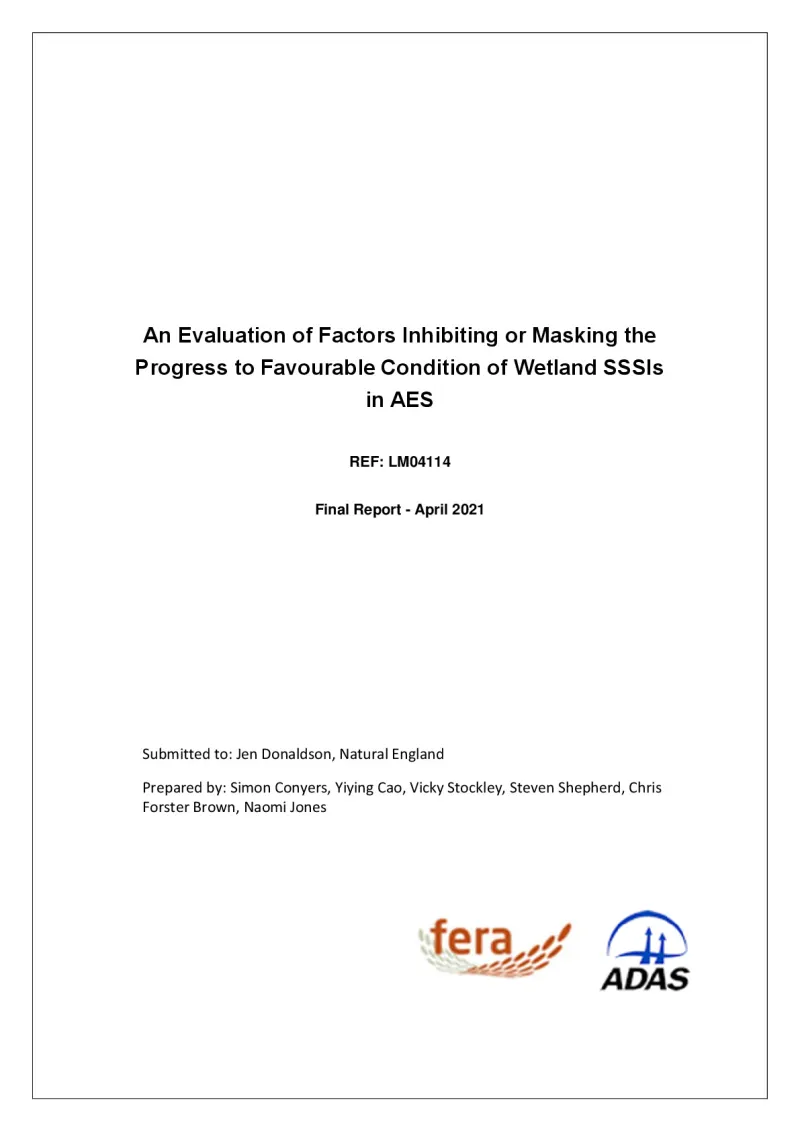Evaluation of factors inhibiting or masking progress to favourable conditions of wetlands
Given the limited positive change of lowland wetland sites, the study evaluates the implementation quality of a sample of Agri-Environment Schemes (AES) agreements.
- Other
- 2014-2022
- Environmental impacts


The purpose of this study, commissioned by DEFRA and Natural England (NE), was to evaluate the set-up and quality of implementation of a sample of AES agreements up to 2019 on lowland wetland sites to identify possible reasons for limited positive change.
For the evaluation, a sample of 40 sites of special scientific interest (SSSI) units were selected from Higher Level Stewardship (HLS) and Countryside Stewardship (CS) agreements.
In addition, a desk study of the ecological and hydrological factors associated with wetland features collated information from a range of sources. including agreement documentation, SSSI data, NE statutory monitoring reports, survey reports and ecohydrological datasets. A series of case study reports evaluated the available information to assess the quality of agreement set-up and to identify any issues or threats.
Online surveys of NE advisers and agreement holders (AH) responsible for the SSSI units collected evidence on AES agreement set up, implementation and impact to evaluate the overall effectiveness of wetland and wet grassland management options. Information was collected on what exactly has changed, in the adviser’s opinion, since the implementation of AES.
In terms of limitations, the main output from the desk-based evaluation was a series of detailed case study reports. Assessments were often challenging because of a range of issues relating to documentation (e.g. missing information, discrepancies in recording and lack of robust spatial information).
Furthermore, the work encountered a number of challenges associated with agreement documentation and other records, which made the interpretation of information difficult, including the absence of key documents/details, discrepancies between different documents and lack of spatial identification of vegetation records. Issues are discussed fully in the results section.
The last challenge was related to sampling. SSSI units and field parcels (usually the smallest ownership scale) were not delineated consistently. In addition, wetland habitats may only be a minor component of an SSSI particularly, but not exclusively, where an SSSI represents a large number of units.
Overall, feedback on the agreement setup was positive, but the feedback for support from NE at the start of the agreement was more positive than that for ongoing support during the implementation. Conversely, support from other organisations was less likely to be considered appropriate by AHs. Most AHs found prescriptions and indicators of success partially appropriate. There was a good understanding of general objectives and indicators of success for wetland/wet grassland options among AHs.
Regarding management changes, physical vegetation control, grazing management and cutting were the most common changes reported by both advisers and AHs. AH and adviser survey results are largely consistent with each other, apart from that the level of change assessed by advisers was higher than that by AHs for changes in the three most commonly reported management practices. Significant changes in grazing are more likely to be experienced on units without a previous AES agreement, particularly for cutting and physical vegetation control. Despite limited management change, most advisers believed that prescribed management changes were sufficient or partially sufficient to move toward favourable wetland conditions. Both AHs and advisers felt AHs' aims aligned well with AES objectives. Issues in implementation included grazing, cutting, physical vegetation control and water level management.
Increasing AHs' confidence and knowledge was reported as the least likely impact, although a higher percentage of AHs noted positive impacts on confidence than knowledge. Factors promoting agreement success included tailored management prescriptions, quality advice and effective implementation. External issues such as drainage and nutrient sources were reported by AHs.
The HLS Farm Environment Plan (FEP) or CS Baseline Evaluation of Higher Tier Agreements (BEHTA) survey information broadly confirmed habitat records from other sources. Generally, the information available indicated a relatively accurate identification of community types, although there were some examples of significant errors which would likely limit the optimal potential of the AES intervention. Option choice was generally appropriate, but wetlands were sometimes overlooked or incorrectly managed.
There was little differentiation between maintenance and restoration prescriptions and indicators of success (IoS). The quality of IoS varied, and where IoS was produced before a complete national vegetation classification survey, target outcomes were less likely to be robust. For a small number of SSSI units, IoS included in the agreements were generic templates. Where wetland was not the main habitat, some agreements included no targets for these habitats. Challenges included managing grazing in complex mosaics and ensuring appropriate water supply for wetland habitats.
This report underscores challenges and limitations in AES management on wetland sites. While setup feedback was positive, there were discrepancies in reported management changes and expectations of improvement. Issues such as adviser expertise and landscape-scale management require further consideration for effective AES implementation.
Author(s)
Natural England